Terms and conditions
Our eyes are incredibly complex, and are one of the most fascinating organs within the human body.
Our skilled staff have an encyclopaedic knowledge of both their various components and how they interact.

Although patients are always given advice in clear and easy-to-understand terms, these are some of the technical phrases you might hear when you visit us for an eye test:
Astigmatism - most of us have some degree of astigmatism, where an irregular shaping of the eye’s curved front cover distorts light rays before they reach the retina. Specially-shaped lenses can compensate for astigmatism’s main symptom – slightly blurry vision at any distance.
Bifocal - available with many spectacle lenses and contact lenses, a bifocal lens is designed to provide two different powers of vision correction. These are typically short-distance for reading, and longer-range for driving or outdoor activities.
Conjunctivitis - one of the most common eye-related conditions, conjunctivitis describes an easily treatable inflammation of the eye’s front tissue layer. Frequently referred to as pinkeye or red-eye due to the discolouration.
Dioptre - this is the official unit of measurement for a lens’s light-bending power (or refractive power). You might recognise it from your prescription – most people are short-sighted, so their dioptre measurement is negative. For example, somebody with -4.5 dioptre lenses would be quite short-sighted.
Floaters - these are the shadowy grey spots and strands that float across your vision and change direction in response to eye movements. Floaters are loose gelatinous strands from the centre of your eye, and they are normally harmless. However, a rapid increase in floater activity may require immediate medical attention.
Photochromic - a relatively recent technological advancement, photochromic lenses can react to light exposure to deliver the benefits of sunglasses in everyday glasses. Photochromic lenses darken in bright conditions and clear in low light, making them an ideal choice for patients with certain eye-related medical conditions.
Kept in the shade
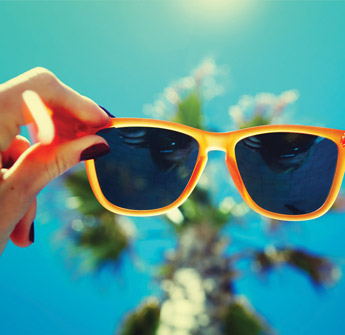
Sunglasses are a valuable ally on a bright day. The sun’s rays are often fierce, particularly when reflecting off a body of water, and tinted lenses provide essential protection against dazzle and harmful light rays.
Sunshine is full of invisible ultraviolet rays, including UVA and UVB waves. Any sunglasses sold by us will prevent both categories of ultraviolet light reaching your eyes, where it can damage retinas, lenses and corneas.
When choosing a new pair of sunglasses, make sure you can’t see over the frames.
"Shatterproof lenses are recommended for any outdoor sports enthusiasts, while hydrophobic coatings help repel water."
They should ideally wrap around at the sides as well, which is why sunglasses lenses are generally larger than in normal glasses. We can offer advice when you’re choosing sunglasses, helping you select the style that’s right for you.
Because they’re always worn outdoors, sunglasses typically lead a harder life than spectacles. Shatterproof lenses are recommended for any outdoor sports enthusiasts, while hydrophobic coatings help repel water. We can apply an anti-reflective coating to the back surface of these lenses, to reduce reflections even when facing away from the sun. Another option involves polarised lenses, these can either be prescription or non-prescription, and they are highly recommended for people with active lifestyles.
Did you know? Many people believe sunglasses originated in 12th-century China. Smoked quartz was fitted into primitive frames held up to the wearer’s face; despite being very expensive, these items were hugely sought after.
Care to be different
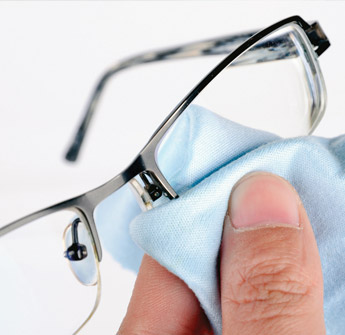
There’s something very satisfying about leaving the practice with a brand new pair of glasses. The frames are flawless, the lenses are completely clean, and we’ve moulded them to fit perfectly on your face.
Keeping your glasses in pristine condition is relatively easy, providing you treat them with care and invest in a few little extras.
Cases are great for overnight storage or holiday transportation – hard shell cases offer more protection than softer leather sleeves, though these are still useful.
A small amount of cleaning spray and a soft lint-free cloth, available from the practice, should be used to clear dust and fingerprints off the lenses every morning.
The best way to ensure children get value-for-money from their glasses is by making them as indestructible as possible to guard against youthful clumsiness. Good quality frames and scratch-proof lenses will be advantageous here, as will impact-resistant lenses for anyone who enjoys outdoor sports.
We may be able to apply anti-scratch coatings to your lenses, since even resting glasses the wrong way up on a bedside table could potentially cause minor abrasions to the lenses. Parents of young children may also benefit from toughened lenses, because it’s hard to predict what toddlers are going to do next...
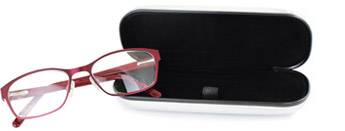
Did you know? There are many urban myths about caring for spectacles. Some people claim egg white or raw potato juice can prevent lenses fogging up, while diluted vodka or vinegar are apparently good for cleaning! We’d always recommend more conventional techniques and have a range of specialised products available.
Design of the times
Invented in 13th century Italy, spectacles have come a long way from hand-made eyeglasses in the 1700s and early attempts at Victorian mass-production.
The comprehensive choice of spectacles in any optician’s practice owes much to this product’s rich history.
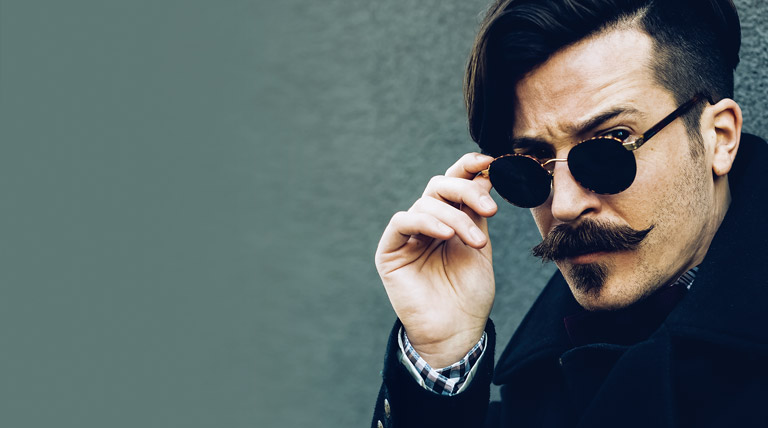
Many of today’s design trends can be traced back to a particular person or event. For example, the 1920s Hollywood star Harold Lloyd pioneered the combination of round lenses in tortoiseshell spectacles – a look that remains popular to this day, particularly in sunglasses.
Sunglasses technology advanced rapidly during World War II to help pilots navigate in the skies, while our obsession with fashion throughout recent decades has encouraged many people to use spectacles as a style piece or as a statement of their personality.
Take a look at the spectacle designs in stock in our practice and you will see numerous variations on a couple of core themes. Full frame glasses are ideal for patients with stronger prescriptions and some of the bolder designs can help to accentuate facial features like cheekbones and eyebrows.
"Advances in the manufacturing of glasses have enabled both frames and lenses to become thinner and stronger at the same time and slimline rectangular glasses are regularly chosen by patients of all ages."
The other leading option involves frameless glasses, where slim lenses are connected directly to the nose-bridge and arms.
Semi-frameless glasses have their lenses suspended along a thin top bar and these are perfect for slimmed-down lenses and mild prescription strengths.
Advances in the manufacturing of glasses have enabled both frames and lenses to become thinner and stronger at the same time and slimline rectangular glasses are regularly chosen by patients of all ages.
Meanwhile, bold retro frames remain popular among younger people who want statement pairs that suit their facial shape and characteristics.
Many of last year’s designer spectacle ranges referenced fashions from the 1950s and 1970s, with oversized frames expected to be popular throughout 2016.
With so many designs to choose between, patients are increasingly deciding to have more than one pair of glasses. Stylish frames for socialising can be balanced against more practical pairs with slightly larger lenses for everyday duties like driving.
Technological advances have also made spectacles more affordable than ever, so it’s easy to keep up with changes to your prescription strength or evolving fashions.
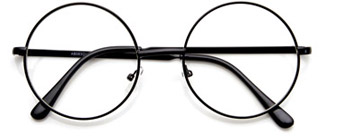
Did you know? Many of the most enduring frame designs can be directly attributed to a single celebrity, from John Lennon’s circular spectacles to Audrey Hepburn’s outsized ‘Breakfast at Tiffany’s’ sunglasses.
Come into the practice to see everything that we have to offer you.
Driving up standards
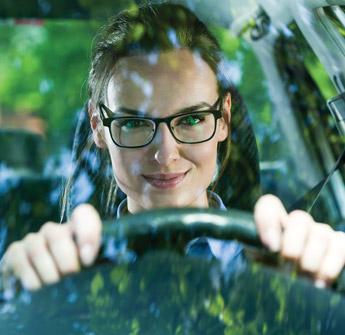
Driving represents a real feat of multitasking, and it places considerable demands on our eyes. From refocusing between distant and near objects through to peripheral sight and night vision, your eyes have to process a great deal of information whenever you’re at the wheel. You won’t be granted a driving licence if your vision is poor, regular eye tests are essential even for occasional motorists.
Many people like to have a dedicated pair of driving glasses in the glovebox, preferably with thin frames to maximise peripheral vision at junctions and roundabouts.
"You won’t be granted a driving licence if your vision is poor, regular eye tests are essential, even for occasional motorists."
Polarised sunglasses or spectacles with anti-reflection coatings can reduce glare and dazzle – our ‘In the shade’ article describes this in more detail.
Effective car maintenance makes a surprisingly big difference to your levels of vision, and even dirty windscreens may cause headaches.
Replace worn wipers, keep washer fluid levels topped up and immediately replace blown headlight bulbs.
Windscreen cracks should be repaired to maintain clear sight lines, and never drive away if your vehicle’s side windows or mirrors are misted up or frozen over.
Did you know? The DVLA needs to be notified about significant changes like glaucoma or cataracts, but only if they affect both eyes.
There are no restrictions regarding colour blindness, but you must have an adequate field of vision – our optometrist(s) can test this easily.
The coming of age

Even though our eyes are effectively fully developed by the age of seven, our teenage years are full of new experiences and firsts that place unique demands on our vision.
Activities like drinking and smoking are known to be harmful, but there are plenty of other challenges for our eyes throughout these years of physical and emotional development...
Secondary school and further education involve large amounts of study, and short-sightedness may develop or become more noticeable during a person’s teens.
Visit us at the practice to see our range of stylish spectacle frames and discuss the advantages of using scratch-proof lenses and flexible frames to improve durability.

A crucial challenge for many teenagers involves learning to drive, where attributes like peripheral vision suddenly come into their own.
Although regular eye tests are vital at any age, it’s essential to ensure you have good overall vision before getting behind the wheel.
Being able to read a number plate from 67 feet away is nowhere near as comprehensive as a professional eye examination but it does reassure driving examiners that you can see clearly!
Did you know? Teenagers are at particularly high risk of sporting-related eye injuries, so shatter proof sunglasses and swimming goggles could be invaluable additions to their wardrobe.








